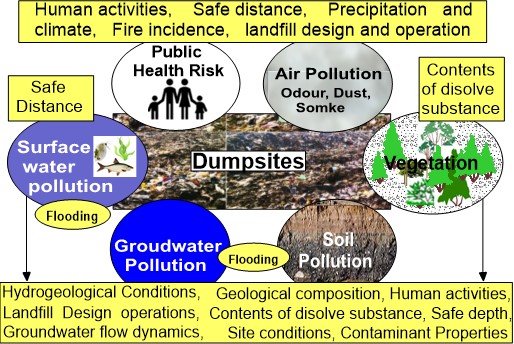The Factors Influencing the Landfill Leachate Plume Contaminants in Soils, Surface and Groundwater and Associated Health Risks: A Geophysical and Geochemical View
DOI:
https://doi.org/10.70737/7ejde223Keywords:
landfill leachate plume, geochemical, geophysical, environmental vital organs, influencing factors, public healthAbstract
Understanding the factors influencing the impacts of landfill leachate plume (LLP) contaminants in soils, surfaces, and groundwater systems is essential in combating landfills' environmental impacts. Previous studies have concentrated on the environmental effects of LLPs, ignoring the influencing factors fueling the impacts. This review explores the factors influencing the migration and distribution of leachate plume contaminants, which inversely exacerbate their venoms on environmental and public health. Some selected leachate plume influencing factors were examined from geophysical and geochemical perspectives. The geophysical view provides valuable information on subsurface influential factors such as the hydraulic properties, geological composition, and the presence of preferential flow pathways that can influence the spread of contaminants. From the compiled studies, these influencing factors of LLPs remain critical conditions for siting bores/wells and landfills. In addition, the geochemical processes such as adsorption, desorption, precipitation, contaminant properties, and microbial transformations influence the fate and transport of LLP contaminants in soils, surface water sources, and groundwater were discussed. The interactions between LLP contaminants and soil, water, organic matter, and microbial communities determine the overall well-being of the environment. Understanding these geochemical and geophysical processes is essential for predicting the long-term behaviour of contaminants and designing effective management strategies. Based on the compiled studies, geophysical regularization requires that drinking water sources should be sited at least 100m away from the landfill to at least 15m depth, while a standard landfill should be located in a zone with deep aquifers. In conclusion, the Integration of geophysical and geochemical approaches provides a comprehensive understanding of the complex interactions between LLP contaminants and the environment, which enables researchers and environmental stakeholders to assess the risks associated with contaminant migration, develop roadmap monitoring programs, and implement sustainable management techniques to protect soil, surface/groundwater resources, and public health from the impacts of LLP pollution.

